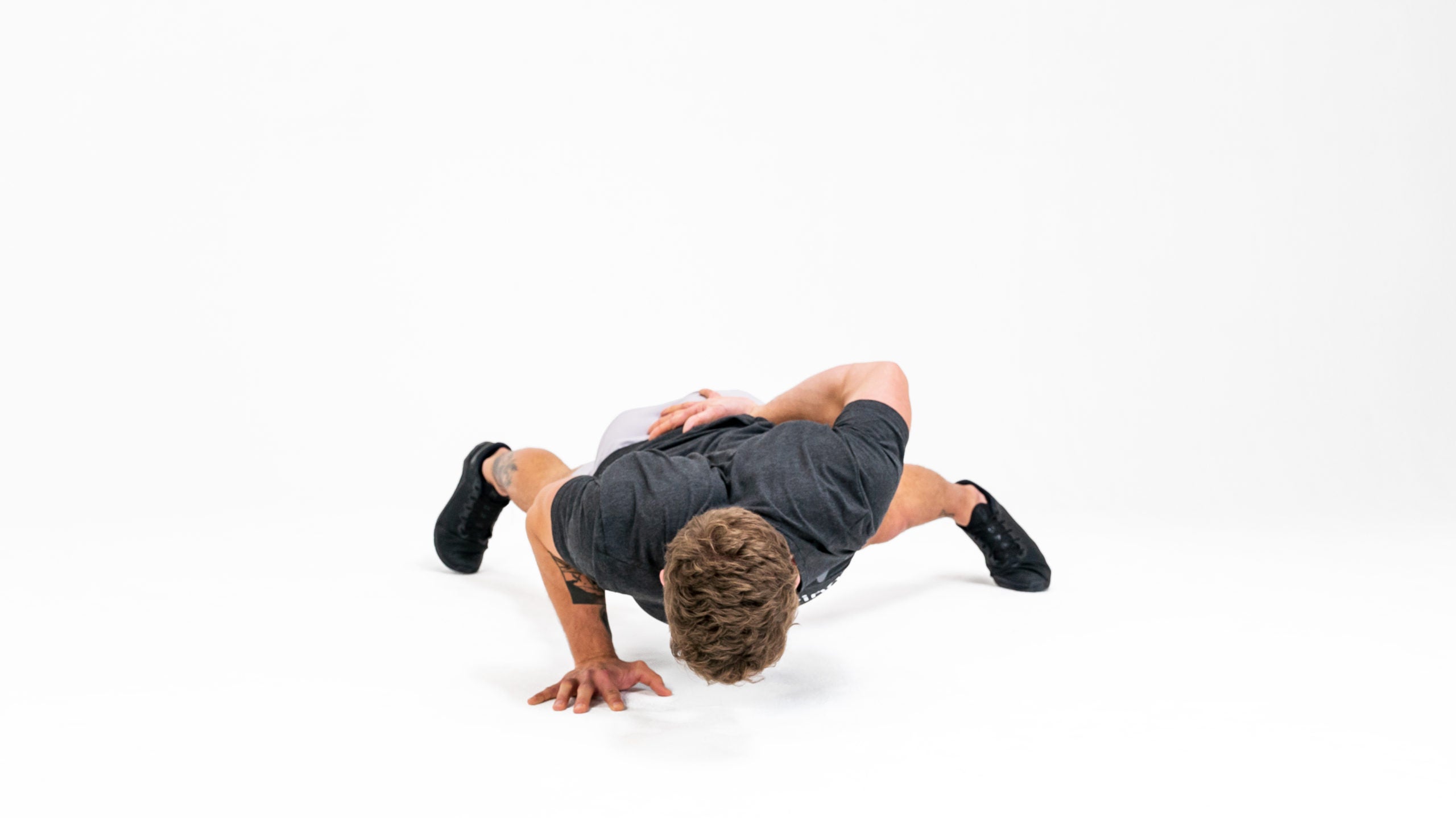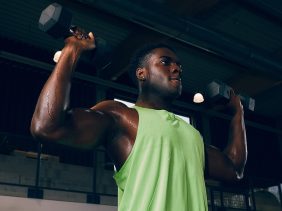Push-Ups: Everything you ever wanted to know!
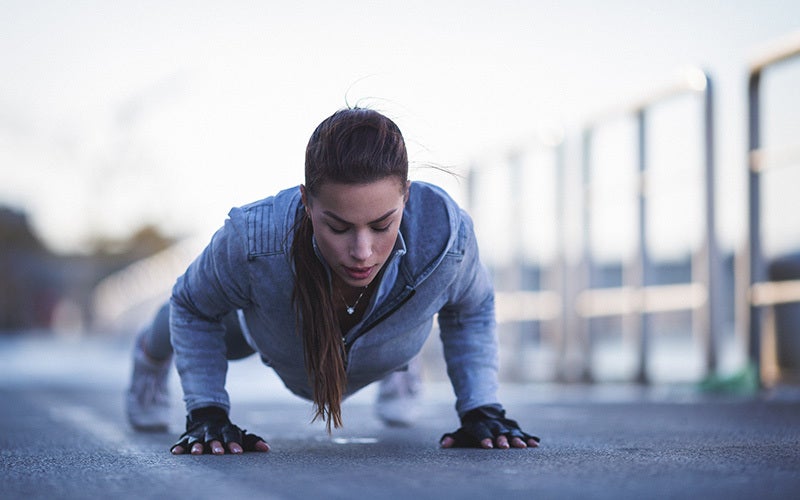 ©danchooalex
©danchooalex
Push-ups are a basic exercise for effective muscle building that is perfect for beginners, experienced, and professional athletes alike. Here’s everything you need to know: from correct execution and common mistakes to push-up variations, calorie expenditure, and more.
What is a push-up?
The push-up, pushup, or press-up is a classic in fitness routines. It can be done anywhere and requires no additional equipment. Not only does a push-up look good, but it’s also a real fitness fundamental. The exercise not only exerts several different muscle groups, but also trains coordination, flexibility, strength endurance, and balance. No wonder push-ups are part of the standard training of the military and police!
What muscles do push-ups train?
You might only associate push-ups with chest day, but this doesn’t quite do the move justice. A push-up trains far more muscles than you thought.
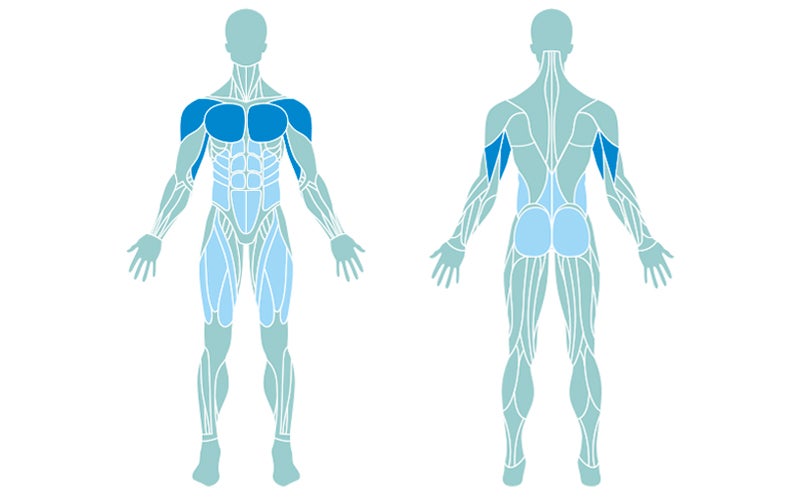
- ©foodspring
Primary muscle groups (marked in dark blue):
- Large and small pectoral muscles (M. pectoralis major and minor): responsible for the extension and adduction of the arms. They’re what push you up during a push-up.
- Triceps (M. triceps brachii): work closely with the pectoral muscles and are responsible for the extension in the arm as you lift your body.
- Anterior deltoid muscle (M. deltoideus pars clavicularis): supports the pectoral muscle and triceps in the extension and adduction of the arms.
Secondary muscle groups (marked in light blue):
- Large and small rhomboid muscles (Mm. Rhomboidei): pull the shoulder blades back and allow you to perform a nice deep push-up.
- Back extensor (erector spinae): stabilizes the core, keeps the spine straight, and allows you to hold yourself in a neutral, straight line.
- Straight abdominal muscle (M. rectus abdominis): stabilizes the core and helps you maintain a straight and neutral position during a push-up.
- External oblique abdominal muscles (M. qbliquus externus abdominis): stabilize the core and keep you in a straight and neutral position
- Internal oblique abdominal muscles (M.obliquus internus abdominis): stabilize the core and keep you in a straight and neutral position
- Transverse abdominal muscle (M. transversus abdominis): stabilizes the core and keeps you in a straight and neutral position
- Leg extensor/ quadriceps femoris: keeps the legs extended.
- Large gluteus maximus muscle (M. gluteus maximus): prevents the pelvis from tilting forward and an overarched back. Your glutes also help keep your upper body straight during push-ups.
Fun fact: the human body contains more than 650 muscles. One push-up engages about 200 of them. Not bad, huh?
What’s the point of push-ups?
Push-ups have numerous benefits for your body. Below we have compiled the most important ones for you.
Do push-ups help build up muscle?
Every exercise that is performed correctly and with the right intensity (including number of sets, repetitions, and recovery breaks) will help increase strength and tone muscle, and that definitely includes push-ups. Because there are so many variations and advanced modifications, anyone – from beginners to hardcore athletes – can get a lot out of them.
Are you getting the urge to work out? With our free foodspring workouts you can train effectively and efficiently at home. Tailored to your goals and your fitness level, you can decide from one of our many different workouts.
Do push-ups boost calorie burn?
Every time you move your body, you burn calories. The more complex and strenuous an exercise is, the more your muscles have to work, and the greater the burn. Push-ups do burn a few calories during the exercise, but the indirect influence is considerably greater. The more you build up your muscles and strength, the higher your basal metabolic rate becomes, and the more calories you burn.
Are push-ups good for the back?
Definitely, but only when performed with proper form. A push-up targets the abs and core muscles in the back that support our upright posture.

- ©takoburito
Step by step: How to do a push-up correctly
Beginners, but also experienced athletes, frequently have problems doing a push-up with proper form.
Starting position:
- For a properly executed push-up, start by kneeling on the floor. Place your hands on the floor about shoulder-width apart, with your fingers pointing forward.
- Stretch out your legs one after the other and raise your knees off the floor. The closer your feet are to each other, the more you engage your back and glutes.
- Check the position of your upper body. Your hands and chest should form a 90-degree angle. If this is not the case, push your torso forward a little.
- The body should form a straight line throughout the exercise. Put your whole body under tension and hold it, especially your stomach, back, and glutes!
Execution:
- From the plank position, slowly bend your arms, pull your shoulders back, and guide your chest towards the floor with control. Point your elbows slightly diagonally backward.
- Inhale while moving down.
- Think of your head as an extension of your spine – it stays straight.
- Go as deep as you can while maintaining the tension in your body.
- When you hit your deepest point, push your body back upwards, always staying in control of the motion.
- Exhale as you do so.
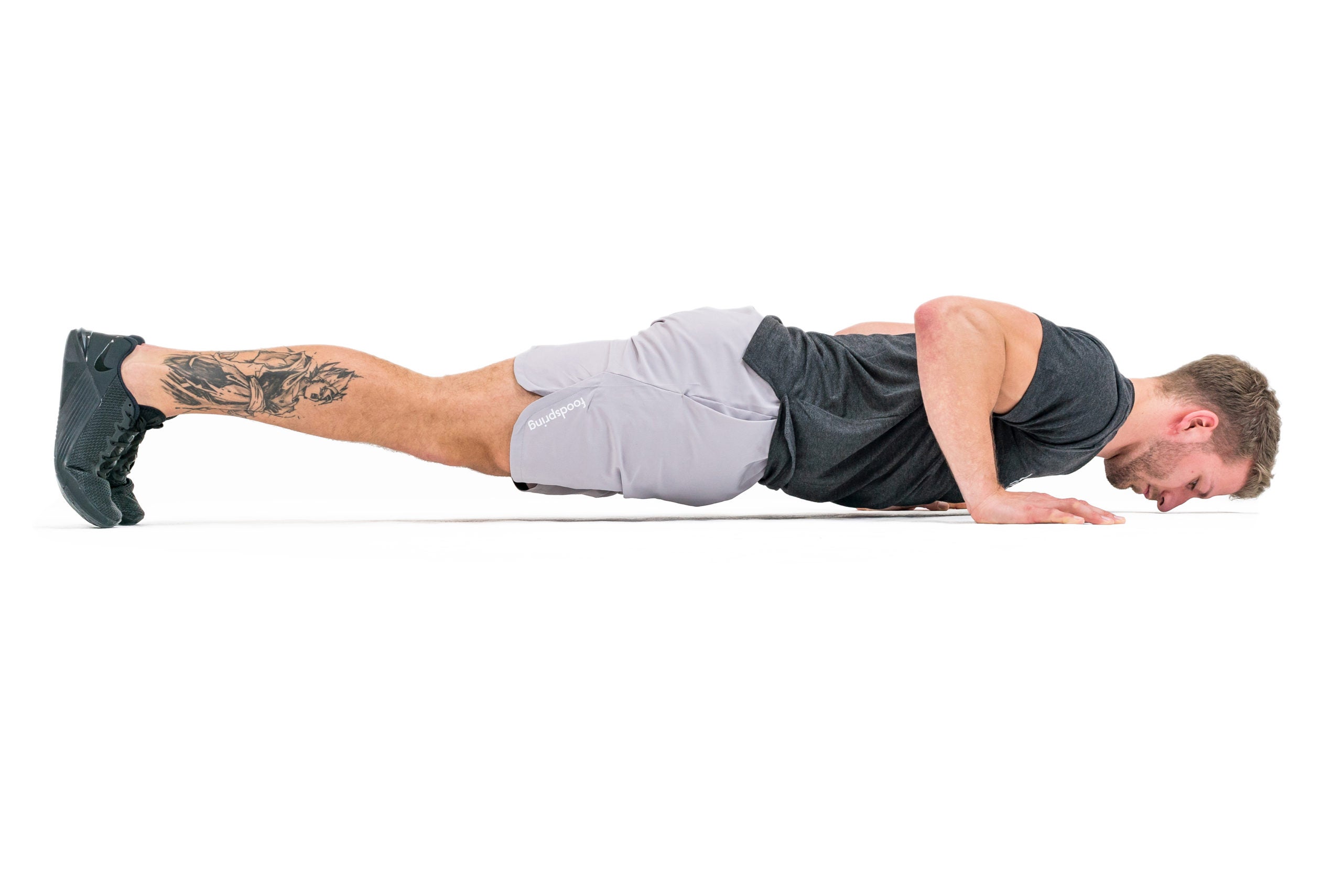
- ©foodspring
Common mistakes and how to avoid them/tips and tricks
#1 Flared elbows/Elbows at a 90-degree angle
Flared out elbows are common, whether intentionally or not. Elbows that are extended outwards until they line up with the shoulders can often lead to the shoulders being pulled forward, which can cause pain in the hand, elbows, and shoulder joints.
Our tip: Hug your elbows in towards your torso as if you were trying to squeeze something between your arms and body. Tense your glutes. Press your palms into the floor, and make sure your fingers are pointing forward.
#2 Wrong hand position
Fingertips or hands turned too far outwards are often related to limited mobility in the shoulder or wrist, as, just like with squats, Turning out makes you feel like you can go deeper. Your palms should never turn inward, either. Keep your shoulders above your wrists, 90-degree angle.
Our tip: To prevent pain and injuries, always point your elbows towards your body and keep your fingertips pointing forward. Press the palm of your hand into the ground to keep this tension.
#3 Lack of body tension – arched or crooked back
If you forget to pay attention when doing push-ups, you might quickly fall into an arched or crooked back, or wind up bending your head back. Ouch!
Our tip: Remember, your body should form a straight line! Treat your head as an extension of your spine. Keep your gaze to the ground! Place your feet close together, tense your glutes, and pull your navel towards your spine. Before each repetition check your posture until you have mastered it perfectly.

- ©Westend61
#4 Freefalling
Are you going faster on the way down than on the way up? If you “fall” during a push-up, not only does it mean you’re not doing the exercise properly, but you’re also wasting a lot of its potential. The lowering movement is the eccentric movement, which significantly contributes to the overall results of the exercise¹.
#5 Halfway There
Mini push-ups won’t get you anywhere quickly. Always try to train with your full range of motion, so you can be sure to work each muscle equally. The greater the range of motion, the more muscles you are using.
Push-ups variations
Just like with squats, there are numerous possibilities to adjust the level of difficulty. So no matter the modification, everyone can improve their fitness and build up muscles with push-ups.
Are you getting the urge to work out? With our free foodspring workouts you can train effectively and efficiently at home. Tailored to your goals and your fitness level, you can choose from our range of different workouts.
Push-up for beginners
If you cannot yet do normal push-ups, you might consider a push-up from your knees. Some people suggest a modified push-up on an elevation in order to gradually work your way down. But not everyone has suitable furniture or training equipment at home.

- ©foodspring
Since you have about 50% less weight on the chest and arms, a push-up with your knees on the ground is an easy and helpful modification. The same rules apply, and it is important to pay particular attention to good back, abdominal and glute engagement.
Note: This variation will still effectively train your upper body. When you have built up enough strength to perform normal push-ups, make sure that you do the exercise with proper form. The sequence of movements is a bit different compared to kneeling push-ups.
What push-up variations are suitable for more experienced & professional athletes?/ advanced variations
Whoever said that you cannot build up muscles with push-ups or that they are too easy has never tried one of many variations.
1. Close Grip Push-Up
This narrow push-up differs from the classic version just in the width of the ‘handle’. The hands are closer together here and the elbows are completely in line with the body, which not only targets the triceps but also your chest muscles.
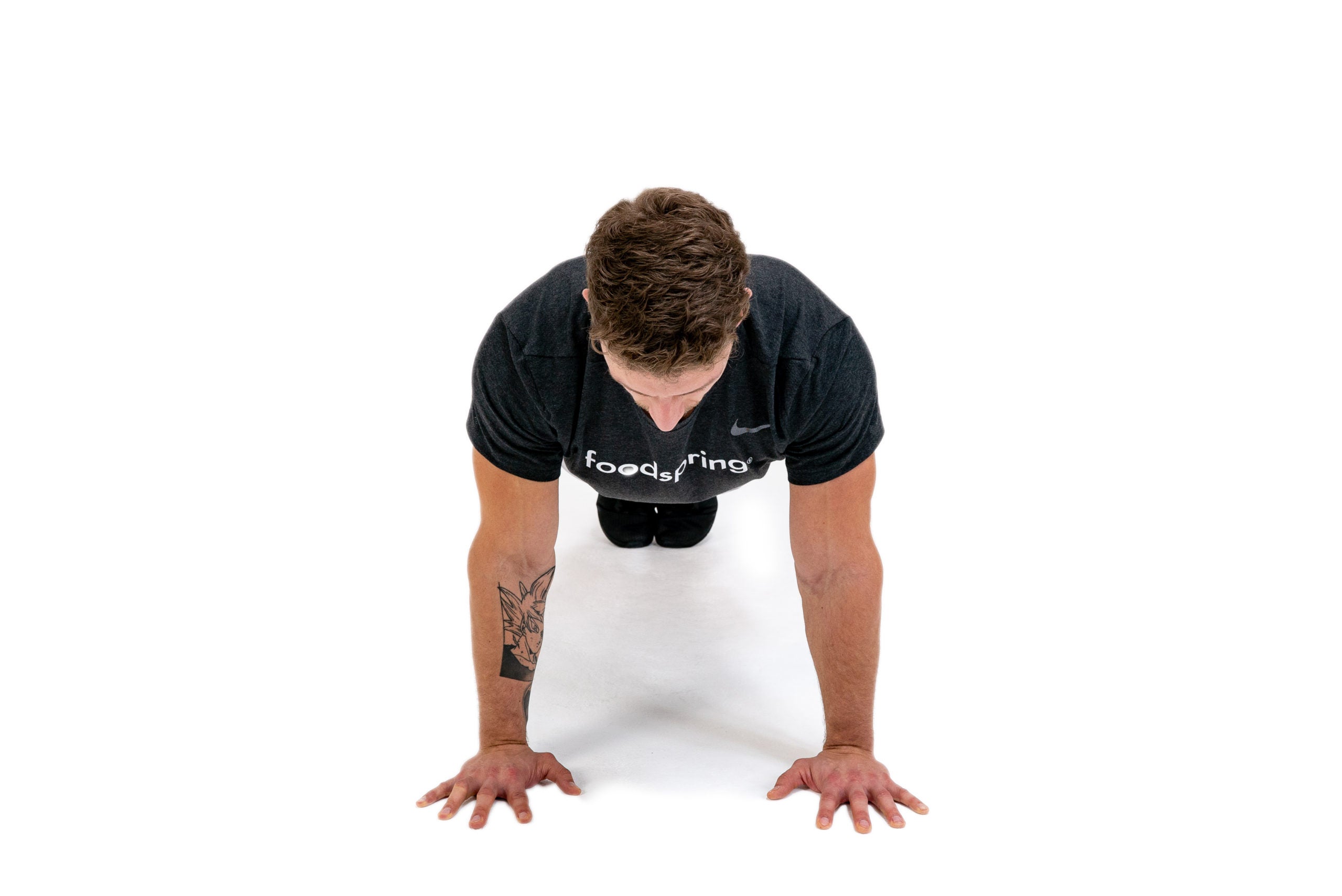
- ©foodspring
2. Diamond Push-Up
Set yourself up as you would with a classic push-up, but position your index fingers and thumbs so that they touch to form a diamond shape. Now place your feet one after the other as normal.
From this modified plank position, slowly bend your arms and guide your chest towards the diamond. Take special care to keep your elbows close to your body.
3. Hand Release Push-Up
The starting position is the same as for the classic or Close Grip Push-up. At the bottom of your push-up, place your body completely on the floor. When on the floor, briefly take your hands off the floor. Keep your elbows towards the ceiling. Then push yourself back up again. The main challenge is to maintain your body tension while you are lying down before pushing back up.
4. Peak Push-up/ Pike Push-Up
The Peak or Pike Push-up is not only great for a nice chest and shoulder workout, but it is also ideal for training towards a handstand. For the Peak Push-up, form a Downward Dog V with the body. Place your hands on the floor about shoulder-width apart and keep your bottom up. Arms and legs should remain stretched out as much as possible. Now bend your arms and move your chest towards the floor. Your forehead should touch the floor between your hands. Then push yourself back again until your arms are stretched out.
5. Explosive Push-Up
As the name suggests, this is an explosive form of push-ups. Starting on your knees, keep yourself upright and your hands at chest level next to the torso. Now drop your upper body towards the floor and catch yourself in the push-up position. Keep your knees on the floor. Push yourself up explosively until your upper body is upright. Maintain the tension on your upper body and torso in particular.
6. Single-Leg Push-Up
When doing push-ups on one leg, your weight is only distributed over 3 points. This exercise is especially demanding on your coordination and balance. Start as you would with a normal push-up and place your feet. Now lift up one foot and hold it in the air. Now bend your arms and bring your chest to the floor. Push yourself up again.
|
|
7. One Hand Push-Up
The one-armed push-up is one of the ultimate variations. The starting position here is also the same as in the classic push-up. You should, however, place your legs further apart from one another. Press them firmly into the ground. If you have difficulty keeping your balance, increase the distance between your legs. The greater the distance, the easier it’ll be to keep your balance. Place one hand on your back and keep the other hand firmly pressed into the ground, with your fingers spread apart. Put your weight on the supporting arm and bend your arm. Go as deep as you can, keeping your elbow pointing towards your torso. Keep tension in your core, especially in your stomach and back. Make sure that your hips do not drop.
|
|
8. Clapping Push-Up
Push-ups with clapping are not only beautiful to observe but are also a super powerful exercise to test your strength. Starting from the normal push-up position, bend your arms and bring your chest to the floor. At the lowest point, push yourself up explosively. As soon as your arms leave the floor, clap your hands together at the top. Quickly replace them below you to catch yourself.

- ©foodspring
How many push-ups should you do?
Because everyone’s physiques, fitness levels, and goals are different, there is no general rule how many push-ups one should do. To build up muscle tone, there should always be a slightly supra-threshold stimulus. This can be after 5 or 50 push-ups, depending on your body.
However, the number of pushups you can perform can provide information about your fitness, performance and state of health. For example, in some states, applicants for the police force must be able to hit the following standards:
| Gender | Number of Pushups |
| Men | 40 |
| Women | 20 |
A new long-term study from Harvard² was able to draw a connection between the number of push-ups performed in a row and heart health. Test subjects who performed 40 or more push-ups in a row had a 96% lower risk of cardiovascular disease.
Did you know: On January 21, 2017, Canadian Mia Hepburn performed 808 push-ups in a row. The Japanese Minoru Yoshida did 10,507 push-ups non-stop in October 1980.
Sources for this article
We at foodspring use only high-quality sources, including peer-reviewed studies, to support the facts within our articles. Read our editorial policy to learn more about how we fact-check and keep our content accurate, reliable, and trustworthy.
- 1 Walker S, Blazevich AJ, Haff GG, Tufano JJ, Newton RU, Häkkinen K., NCBI, “Greater Strength Gains after Training with Accentuated Eccentric than Traditional Isoinertial Loads in Already Strength-Trained Men.”, at: https://www.ncbi.nlm.nih.gov/pubmed/27199764 (last accessed on 08.04.2020).
- 2 Yang J., Christopphi C.A., Farioli A. et.al., “Association Between Push-up Exercise Capacity and Future Cardiovascular Events Among Active Adult Man”, at: https://jamanetwork.com/journals/jamanetworkopen/fullarticle/2724778 (last accessed on 08.04.2020).





























